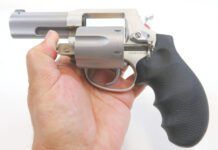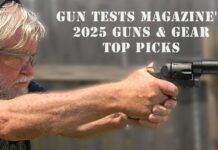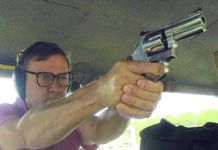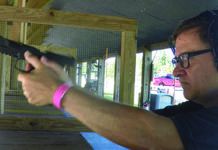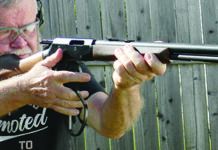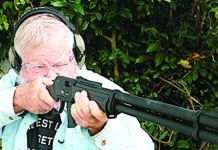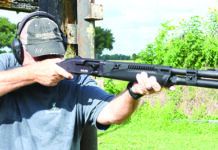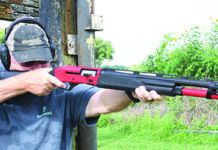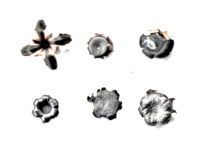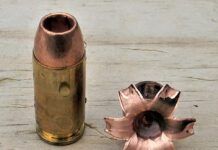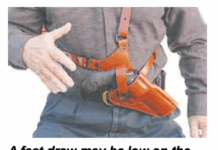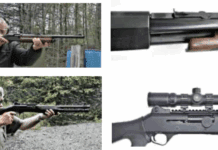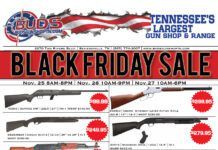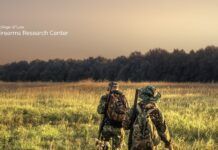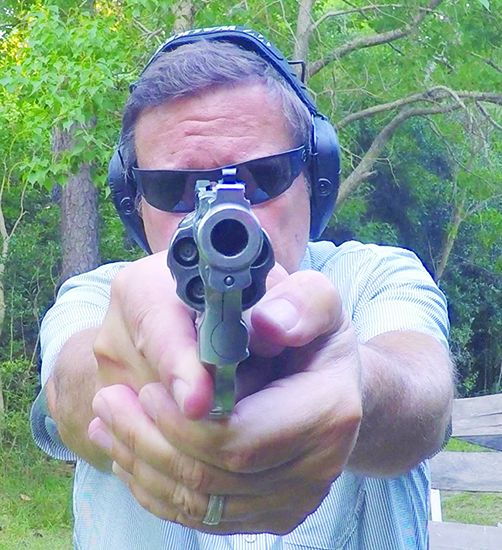Offering custom treatments on revolvers is a tradition among wheelgun manufacturers. In fact, Smith & Wesson, Ruger, and Taurus all produce custom-shop variants of popular models. These gun receive extra fitting handwork, along with premium finishes and tuned actions. Many are also tweaked for a specific task, such as everyday carry (EDC), competition, or a viable choice as a fancy BBQ gun. We acquired three revolvers given such glam and performance makeovers at the factory:
● The S&W Performance Center Pro Model 640 takes a factory J-frame and transforms it into a very capable EDC option.
● The Taurus Model 605 Executive is one of the nicest 605s we have ever handled. Taurus has given the Executive treatment to a few of their revolvers. All of these guns are made in Brazil and assembled by one gunsmith from start to finish.
● The Ruger SP101 Match Champion evolves the ugly duckling SP101 into a swan with beauty and performance.
All three revolvers use a small frame; hence, they have five-round capacities. They also share high-visibility sights, with some being better than others. Barrels lengths varied from 2 to 4.2 inches. The Taurus and the Ruger have double-action-to-single-action triggers, while the S&W has a DAO trigger. Grip sizes ranged from small on the S&W and Ruger to medium on the Taurus. Because these revolvers vary quite a bit from each other, in this evaluation we’re comparing the custom gun to similar guns we’ve handled by the three makers in the past.
With that said, we feel that all three of these revolvers showcase the manufacturers’ factory-customization skills, but of course, these upgrades and treatments come at an additional cost, about $600 starting with the Taurus and upwards to $800 for either the S&W or Ruger. Is the custom work worth the extra dinero? We think it is, depending on what you are looking for. All of these revolvers performed well. Yes, you’ll see our gripes about their double-action trigger pulls. One would think a factory-custom revolver would have a DA trigger-pull weight in the single digits. On the plus side, there was not a lot of stacking in DA mode. The grips allowed use of a strip-style speed loader, but empties hung up on the edges of the grips. In the end, the beauty of these guns is in the eye of the beholder.
How We Tested
All of the revolvers checked out with proper cylinder-to-frame headspace and barrel-and-chamber alignment. As a reminder, the typical space from the forcing cone to the front of the cylinder should be from 0.004 to 0.010 inches, with the Taurus at 0.005 inch, the Ruger at 0.006 inch, and the Smith at 0.009 inch. A larger cylinder gap can allow gases to escape from the side of the gun when shooting, which we experienced with one of the revolvers.
To level the playing field for accuracy testing, due to the S&W being a DAO carry-type revolver, we set targets at 15 yards. The Taurus and Ruger we fired in single-action mode at 15 yards. At 7 yards, we tested for speed and accuracy using IDPA cardboards targets with perforated zones. All speed shooting was done in DA mode, and we spit lead out of these revolvers as fast as we could, pushing ourselves to the edge of our ability while not eroding our accuracy. There were very few hits outside the A zone once we acclimated to the guns, and then we clustered shots into large holes.
Test ammo consisted of 38 Special, 38 Special +P, and 357 Magnum choices; Aguila 357 Magnum ammo loaded with 158-grain SJSP bullets, Blazer 38 Special +P loaded with 125-grain JHPs, and Armscor 38 Special with 158-grain FMJs. As you might assume, recoil was noticeable with 357 Mag ammo and pleasant with 38 Specials.
We used the S&W with and without the moon clips, and we used Tuff Products QuickStrips ($12; TuffProducts.com) speed loaders on all of the revolvers. The Tuffs are flexible strips of polymer that hold cartridges in a row. You can load two chambers at a time with the QuickStrips, and they lay flat in a pocket for concealed-carry reloads.
All of these 357s performed well, but there were differences when the data was tabulated and empties picked up. Here’s what we thought:
Smith & Wesson Performance Center Pro Model 640 178044 357 Magnum
$774
Gun Tests grade: A-
The Model 640 has a smooth trigger and large, useful sights. Recoil is stout in 357 Mag, but gentler in 38 Special loads. Took moon clips and was sleek and snag-free. Accuracy was acceptable for a DAO revolver. It’s a good choice for an EDC revolver.
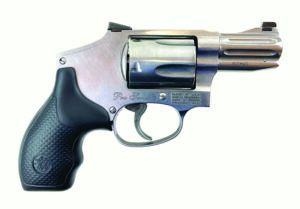
| Action Type | Double-action-only revolver |
|---|---|
| Overall Length | 6.6 in. |
| Barrel Length | 2.1 in. |
| Sight Radius | 3.8 in. |
| Overall Height | 4.3 in. |
| Maximum Width | 1.3 in. |
| Weight Unloaded | 22.4 oz. |
| Weight Loaded | 24.4 oz. |
| Cylinder Gap | 0.009 in. |
| Capacity | 5 |
| Frame Material | Matte stainless steel |
| Barrel | Matte stainless steel |
| Cylinder | Matte stainless steel |
| Frame Front Strap Height | 1.8 in. |
| Frame Back Strap Height | 3.1 in. |
| Grip | Textured rubber w/finger grooves |
| Grip Thickness (Maximum) | 1.2 in. |
| Grip Circumference (Maximum) | 4.6 in. |
| Front Sight | Tritium night sight, dovetailed base |
| Rear Sight | Tritium night sight, dovetailed base |
| Trigger Pull Weight (Double Action) | 14.0 lbs. |
| Trigger Span (Double Action) | 2.9 in. |
| Safety | Internal rebound, hammer block |
| Warranty | 1 year |
| Telephone | (800) 331-0852 |
| Website | Smith-Wesson.com |
| Made In | U.S. |
The Model 640 comes from the S&W Performance Center and is part of the Pro Series. This J-frame is tweaked for optimal concealed carry and offers a good compromise of weight, power, concealment, and capacity. Made entirely of stainless steel, the 640 weighs 22.4 ounces unloaded. That may seem like a ton for a J-frame, but you will appreciate the extra weight when touching off 357 Magnum ammo. The 2.1-inch barrel is fluted for good looks and perhaps a small reduction in weight. The lug is tapered to allow for easy holstering.
The frame is closed around the hammer, making this revolver snag free. The compromise with that is the trigger is double action only (DAO). The trigger was very smooth, so the 14-pound pull weight felt less. The trigger itself has a smooth surface.
The cylinder had a hint of wiggle, and it locks in place at the front with a hole in the end of the ejector rod and a detent in the ejector shroud. At the rear, it locked via a pin in the ejector and frame.

The cylinder is cut to allow the use of moon clips, which made fast reloads a cinch with the 640. However, the moon clips were a pain to load and remove the empty shells. We recommend a moon clip tool to load and unload them. TK Custom (TKCustom.com) offers a loading tool, $70, and unloading tool, $30. But you do not need to use the moon clips if you don’t want to. The chamber mouths had a slight chamfer, and we would have liked more of those edges relieved to better ease reloading, especially with moon clips or speed loaders.
Both rear and front sights are dovetailed into the gun. The front is a large Trijicon dot night sight. The rear is two same-size night-sight dots on each side of the notch. We thought these sights worked well. They were fast to acquire. The top of the frame is fluted for aesthetics and another slight reduction in weight reduction.
The grip is S&W’s excellent rubber single-finger-groove model with a pebbled texture and slight palm swell. These grips offer maximum concealment because they are small, yet they fill your hand better than most small grips. This grip allows a high hold on the 640, which aids in managing recoil and muzzle flip.
Going hot, we found the 640’s DAO trigger was not that much of a liability in accuracy testing. Our best group was with the hot Aguila 357 Mag ammo loaded with a 158-grain SJHP, which is good medicine for bad actors. The smallest group measured 1.87 inches and averaged 2.73 inches. The Blazer 38 Special +P with a 125-grain JHP bullet gave us a best group that measured 2.27 inches; average was 3.04 inches. The mild Armscor 38 Special rounds with a 158-grain FMJ had a best group of 3.41 inches and averaged 3.79 inches. You are thinking right if you guess that the recoil with 357 Magnum was heavy. We used shooting gloves, which helped to lessen the slap in our palm. With +P and regular 38 Special rounds, recoil was tolerable.
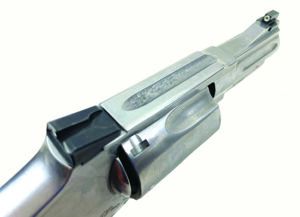
The 640 excelled in the speed round, with good accuracy, manageable recoil due to a high grip, and easy-to-acquire sights. The high hold allowed us to get on top of the recoil. We did note some splash from some ammo, and that was probably due to the 0.009-inch gap between the forcing cone and the cylinder. In the speed drills, the center-of-mass A zone was simple to hit. We staged the 640’s trigger on the cranial A-zone shots because we needed to be more surgical. With training, nearly any DA trigger can be pressed rearward until the shot is ready to break. A short press thereafter fires the revolver. DAO trigger and surgical aren’t usually used in the same sentence, but if you stage the trigger, the last bit of press is close to a single-action pull.
The cylinder latch slides with a bit of grit, but it worked well. The short ejector rod means you need gravity’s help to unload the chambers.
Our Team Said: The Model 640 is an excellent choice for EDC due to the snag-free exterior, lighter weight, and high grip. The trigger was heavy, which we dinged it a half grade for, but very smooth. The ability to use moon clips means the 640 can be reloaded faster. Accuracy was good for a DAO revolver. The sights were very good. If you are leaning toward a 357 Magnum for EDC, this would be a very good choice.
| 38 SPECIAL/357 MAGNUM RANGE DATA | |||
|---|---|---|---|
| Aguila 357 Magnum 158-grain SJSP | Ruger SP101 Match Champion | S&W Model 640 Performance Center Pro | Taurus 605 Executive |
| Average Velocity | 1229 fps | 1026 fps | 1061 fps |
| Muzzle Energy | 530 ft.-lbs. | 369 ft.-lbs. | 395 ft.-lbs. |
| Smallest Group | 2.12 in. | 1.87 in. | 2.26 in. |
| Average Group | 2.65 in. | 2.73 in. | 2.38 in. |
| Blaser 38 Special +P 125-grain JHP | Ruger SP101 Match Champion | S&W Model 640 Performance Center Pro | Taurus 605 Executive |
| Average Velocity | 995 fps | 890 fps | 963 fps |
| Muzzle Energy | 275 ft.-lbs. | 220 ft.-lbs. | 257 ft.-lbs. |
| Smallest Group | 1.99 in. | 2.27 in. | 1.52 in. |
| Average Group | 2.00 in. | 3.04 in. | 1.65 in. |
| Armscor 38 Special 158-grain FMJ | Ruger SP101 Match Champion | S&W Model 640 Performance Center Pro | Taurus 605 Executive |
| Average Velocity | 897 fps | 830 fps | 839 fps |
| Muzzle Energy | 282 ft.-lbs. | 241 ft.-lbs. | 247 ft.-lbs. |
| Smallest Group | 1.58 in. | 3.41 in. | 1.33 in. |
| Average Group | 1.59 in. | 3.79 in. | 1.35 in. |
To collect accuracy data, we fired five-shot groups from a bench using a rest. Distance: 15 yards with open sights. Velocities and energies were recorded using a Garmin Zero C1 Pro chronograph.
Written and photographed by Robert Sadowski, using evaluations from Gun Tests Team members. GT



